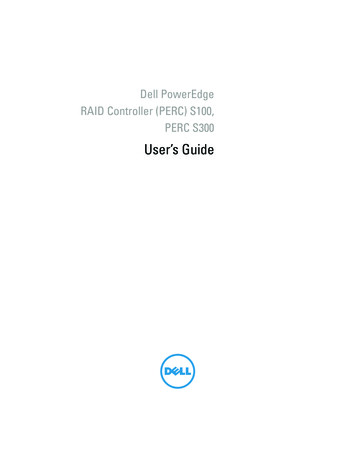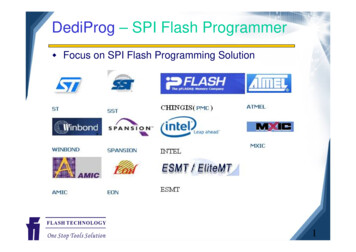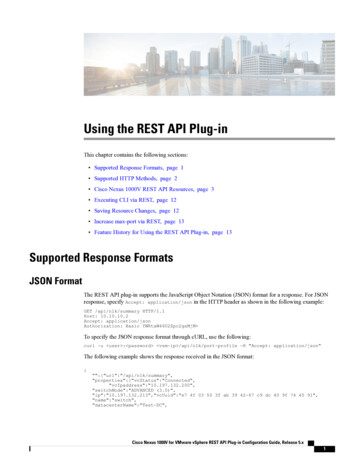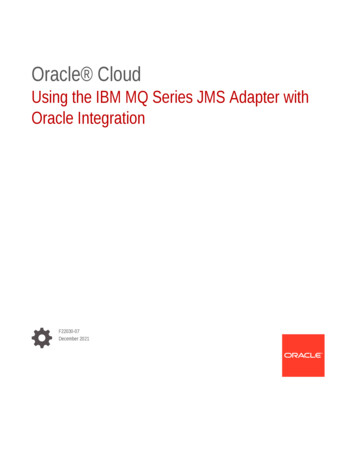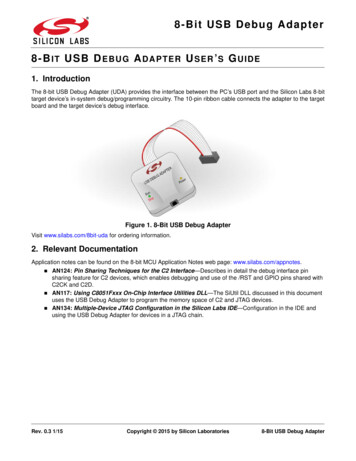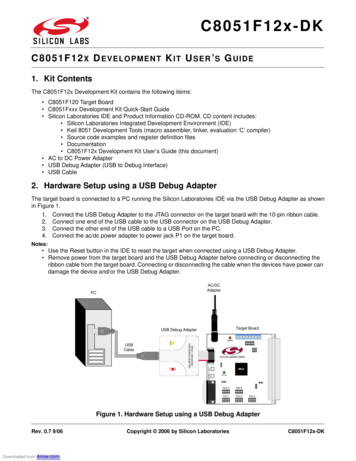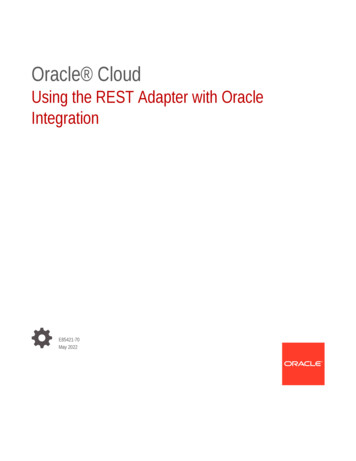
Transcription
Oracle CloudUsing the REST Adapter with OracleIntegrationE85421-70May 2022
Oracle Cloud Using the REST Adapter with Oracle Integration,E85421-70Copyright 2017, 2022, Oracle and/or its affiliates.Primary Author: Oracle CorporationThis software and related documentation are provided under a license agreement containing restrictions onuse and disclosure and are protected by intellectual property laws. Except as expressly permitted in yourlicense agreement or allowed by law, you may not use, copy, reproduce, translate, broadcast, modify, license,transmit, distribute, exhibit, perform, publish, or display any part, in any form, or by any means. Reverseengineering, disassembly, or decompilation of this software, unless required by law for interoperability, isprohibited.The information contained herein is subject to change without notice and is not warranted to be error-free. Ifyou find any errors, please report them to us in writing.If this is software or related documentation that is delivered to the U.S. Government or anyone licensing it onbehalf of the U.S. Government, then the following notice is applicable:U.S. GOVERNMENT END USERS: Oracle programs (including any operating system, integrated software,any programs embedded, installed or activated on delivered hardware, and modifications of such programs)and Oracle computer documentation or other Oracle data delivered to or accessed by U.S. Government endusers are "commercial computer software" or "commercial computer software documentation" pursuant to theapplicable Federal Acquisition Regulation and agency-specific supplemental regulations. As such, the use,reproduction, duplication, release, display, disclosure, modification, preparation of derivative works, and/oradaptation of i) Oracle programs (including any operating system, integrated software, any programsembedded, installed or activated on delivered hardware, and modifications of such programs), ii) Oraclecomputer documentation and/or iii) other Oracle data, is subject to the rights and limitations specified in thelicense contained in the applicable contract. The terms governing the U.S. Government’s use of Oracle cloudservices are defined by the applicable contract for such services. No other rights are granted to the U.S.Government.This software or hardware is developed for general use in a variety of information management applications.It is not developed or intended for use in any inherently dangerous applications, including applications thatmay create a risk of personal injury. If you use this software or hardware in dangerous applications, then youshall be responsible to take all appropriate fail-safe, backup, redundancy, and other measures to ensure itssafe use. Oracle Corporation and its affiliates disclaim any liability for any damages caused by use of thissoftware or hardware in dangerous applications.Oracle, Java, and MySQL are registered trademarks of Oracle and/or its affiliates. Other names may betrademarks of their respective owners.Intel and Intel Inside are trademarks or registered trademarks of Intel Corporation. All SPARC trademarks areused under license and are trademarks or registered trademarks of SPARC International, Inc. AMD, Epyc,and the AMD logo are trademarks or registered trademarks of Advanced Micro Devices. UNIX is a registeredtrademark of The Open Group.This software or hardware and documentation may provide access to or information about content, products,and services from third parties. Oracle Corporation and its affiliates are not responsible for and expresslydisclaim all warranties of any kind with respect to third-party content, products, and services unless otherwiseset forth in an applicable agreement between you and Oracle. Oracle Corporation and its affiliates will not beresponsible for any loss, costs, or damages incurred due to your access to or use of third-party content,products, or services, except as set forth in an applicable agreement between you and Oracle.
ContentsPreface1AudienceviiiDocumentation AccessibilityviiiDiversity and InclusionixRelated ResourcesixConventionsixUnderstand the REST AdapterREST Adapter Capabilities1-1REST Adapter Restrictions1-5Swagger/OpenAPI RestrictionsPublish Restrictions1-7Consume Restrictions1-7REST Adapter Use CasesWorkflow to Create and Add a REST Adapter Connection to an Integration21-71-91-10REST Adapter ConceptsAuthentication SupportAuthenticate Requests for Invoking Oracle Integration Flows2-12-1About Requests to Invoke Integrations2-2About OAuth 2.0 Grants2-3Use OAuth 2.0 Grants2-9Authentication Types2-28Role-Based Connections2-28Extensibility Support for Multiple OAuth Providers2-29REST API Support2-30Oracle Cloud Infrastructure REST API Support with the OCI Signature Version 1Security Policy2-30On-Premises REST API Support with the Agent2-30Swagger and RAML Document Support for Describing External REST APIs2-31OpenAPI Support2-41iii
Support for Publishing Interfaces for Oracle Integration Flows as OpenAPI Documents2-41Consumption of OpenAPI Multipart for JSON and Form Data2-41Attachment Support2-42Multipart Attachment Support for Trigger and Invoke Connections2-42Support for application/octet-stream MIME Attachment (Binary) Payloads2-46Header, Token, Query Parameter, and Array Support2-48Standard and Custom Header Support2-48Nonstandard JWT Token Support2-49RFC 3986 Support for Encoding Query Parameters2-50Homogenous Multidimensional Array Support in JSON Documents2-50Swagger Support2-52REST Endpoint Metadata and a Swagger Link to a REST Metadata Description2-52View the Metadata for the Inbound REST Endpoint in Swagger Format2-53Security is Not Required for Swagger Definition and Metadata Catalog URLConnections2-54Mapper Connectivity Properties Support2-54Set REST Adapter Connectivity Properties in the Mapper2-54REST Endpoint Support2-58Support for Dynamic REST Endpoints2-58Configuration Parameters2-60Cross-Origin Resource Sharing (CORS) Support2-60Cross-Origin Resource Sharing (CORS)2-60Complex Schema Support2-62Complex Schema Support32-62Create a REST Adapter ConnectionPrerequisites for Creating a Connection3-1Create a Connection3-4Configure Connection Properties for Invoke Connections3-5Configure Connection Security3-6Configure an Agent Group3-16Test the Connection3-16Upload an SSL Certificate43-16Add the REST Adapter Connection to an IntegrationAdd the REST Adapter as a Trigger Connection4-1REST Adapter Trigger Resource Configuration Page4-2REST Adapter Trigger Operations Page4-4REST Adapter Trigger Basic Information Page4-4REST Adapter Trigger Request Parameters Page4-5iv
REST Adapter Trigger Request Page4-6REST Adapter Trigger Request Header Page4-8REST Adapter Trigger CORS Configuration Page4-9REST Adapter Trigger Response Page4-10REST Adapter Trigger Response Header Page4-12REST Adapter Trigger Operation Selection Page4-13Summary Page4-14Add the REST Adapter as an Invoke Connection54-14REST Adapter Invoke Basic Information Page4-14REST Adapter Invoke Request Parameters Page4-16REST Adapter Invoke Request Page4-17REST Adapter Invoke Request Headers Page4-19REST Adapter Invoke Response Page4-21REST Adapter Invoke Response Header Page4-23REST Adapter Invoke Operation Selection Page4-24Summary Page4-25Implement Common Patterns Using the REST AdapterBest Practices for Invoking REST Endpoints5-2Configure the REST Adapter to Consume a REST API Protected with OAuth Custom TwoLegged Token-Based Authentication5-2Configure the REST Adapter to Consume a REST API Protected with OAuth CustomThree Legged Flow Token-Based Authentication5-9Understand Security Configurations for Invoking Popular OAuth-Protected APIs5-13Configure the REST Adapter to Consume a REST API Protected with the API Key5-13Configure the REST Adapter to Consume a REST API Protected with OAuth 1.0 OneLegged Authentication5-14Allow Client Applications to Consume an Integration Exposed as an OAuth-ProtectedREST API5-16Override the Endpoint URI/Host Name for an External REST API at Runtime5-16Map to Construct the Payload for an External REST API that Accepts multipart/form-dataas the Content Type5-18Configure the REST Adapter to Consume an External REST API Described Using aSwagger Document5-22Configure the REST Adapter to Consume an External REST API Described Using a RAMLDocument5-23Configure the REST Adapter to Consume an External REST API with No MetadataDescribed in a Document5-23Implement an Integration in which to Send an Incoming Message with a Base64-EncodedString to an External REST API that Accepts a Multipart Attachment5-27Map JSON when the REST Adapter Request is Configured with multipart/form-data5-28Pass the Payload as URL-Encoded Form Data5-29v
6Implement an Integration to Send a PDF/CSV Document Downloaded from an SFTPServer to an External REST API that Accepts Only application/octet-stream as the ContentType5-30Configure the REST Adapter to Expose an Integration as a REST API5-34Configure a REST Adapter to Consume a REST API that Expects Custom HTTP HeaderProperties5-35Configure the REST Adapter to Consume an Amazon Web Services (AWS) REST API5-36Enter q as a Standard HTTP Query Parameter with the Query as a Value5-37JSON to XML Special Character Conversion5-37Publish REST-Based Integrations as OpenAPI Documents5-39Consume and Publish OpenAPI Documents with Multipart/Mixed and Multipart/Form-Data5-40Configure Oracle Integration to Call Oracle Cloud Infrastructure Functions with the RESTAdapter5-44Configure a REST Adapter Trigger Connection to Work Asynchronously5-46Send an Empty JSON Object5-47Create a Keystore File for a Two-Way, SSL-Based Integration5-48Troubleshoot the REST AdapterConvert a Private Key from PKCS8 to RSA (PKCS1) Format for the OCI Signature Version1 Security Policy6-2HTTP Error Response for Pre-20.4.2 Connections is Not Compliant with the OpenAPISpecification6-2REST Services that Return Multiple Successful Responses6-4Error Handling with the REST Adapter6-4REST Service Invoked by the REST Adapter Returns a 401 Unauthorized StatusResponse6-7Configuration Limitation of Ten Pages in the Adapter Endpoint Configuration Wizard6-8Keys with Null Values During JSON Transformation are Removed6-8Large Sample JSON File Processing with Special Characters6-9SSL Certification Troubleshooting Issues6-9Fault and Response Pipeline Definitions in Basic Routing Integrations6-9Empty Arrays Are Not Supported in Sample JSON Files6-11Invoke Endpoint URI Must Match the Base URI Resource URI in REST Adapter6-12JD Edwards Form Service Invocation with the REST Adapter Causes APIInvocation Error6-12REST Adapter Data is Only Saved When You Click Next6-13Convert XML to a JSON Document6-13Supported Special Characters in JSON Samples6-14content-type is Missing for an Asynchronous Flow6-14REST URLs Exceeding 8251 Characters Fail6-15Send a "null" Value Instead of "" for Any Specific Key in JSON Through the REST Adapter6-15vi
7REST Adapter SamplesBuild an Integration that Exposes the REST API Using the REST Adapter7-1vii
PrefacePrefaceThis guide describes how to configure this adapter as a connection in an integration inOracle Integration.Note:The information in this guide applies to all of your Oracle Integrationinstances. It doesn’t matter which edition you’re using, what features youhave, or who manages your cloud environment. You’ll find what you needhere, including notes about any differences between the various flavors ofOracle Integration when necessary.Topics: Audience Documentation Accessibility Diversity and Inclusion Related Resources ConventionsAudienceThis guide is intended for developers who want to use this adapter in integrations inOracle Integration.Documentation AccessibilityFor information about Oracle's commitment to accessibility, visit the OracleAccessibility Program website at http://www.oracle.com/pls/topic/lookup?ctx acc&id docacc.Access to Oracle SupportOracle customers that have purchased support have access to electronic supportthrough My Oracle Support. For information, visit http://www.oracle.com/pls/topic/lookup?ctx acc&id info or visit http://www.oracle.com/pls/topic/lookup?ctx acc&id trs if you are hearing impaired.viii
PrefaceDiversity and InclusionOracle is fully committed to diversity and inclusion. Oracle respects and values having adiverse workforce that increases thought leadership and innovation. As part of our initiative tobuild a more inclusive culture that positively impacts our employees, customers, andpartners, we are working to remove insensitive terms from our products and documentation.We are also mindful of the necessity to maintain compatibility with our customers' existingtechnologies and the need to ensure continuity of service as Oracle's offerings and industrystandards evolve. Because of these technical constraints, our effort to remove insensitiveterms is ongoing and will take time and external cooperation.Related ResourcesSee these Oracle resources: Oracle Cloudhttp://cloud.oracle.com Using Integrations in Oracle Integration Using the Oracle Mapper with Oracle IntegrationConventionsThe following text conventions are used in this document:ConventionMeaningboldfaceBoldface type indicates graphical user interface elements associated with anaction, or terms defined in text or the glossary.italicItalic type indicates book titles, emphasis, or placeholder variables for whichyou supply particular values.monospaceMonospace type indicates commands within a paragraph, URLs, code inexamples, text that appears on the screen, or text that you enter.ix
1Understand the REST AdapterReview the following conceptual topics to learn about the REST Adapter and how to use it asa connection in integrations in Oracle Integration. A typical workflow of adapter andintegration tasks is also provided.Topics: REST Adapter Capabilities REST Adapter Restrictions REST Adapter Use Cases Workflow to Create and Add a REST Adapter Connection to an IntegrationREST Adapter CapabilitiesThe REST Adapter can expose integrations as REST APIs by configuring a REST Adapterconnection as a trigger. The REST Adapter can also consume any external REST API byconfiguring a REST Adapter connection as an invoke. This section identifies the capabilitiesof the REST Adapter when used as a trigger or invoke connection.Note:The REST Adapter treats all endpoints as they are exposed. The REST Adapterdoes not filter or change any of the APIs exposed by the application to which youare connecting. If there is a native adapter for the application to which you areconnecting, use that adapter instead. If you choose to use the REST Adapterinstead of the native adapter, the API restrictions and deprecation policies apply asspecified in the respective application’s documentation.To connect to the Oracle HCM Cloud SOAP APIs, see Oracle HCM Cloud AdapterCapabilities. REST Adapter Capabilities When Exposing an Integration as a REST API by Configuringthe Connection as a Trigger REST Adapter Capabilities When Consuming External REST APIs by Configuring theConnection as an InvokeREST Adapter Capabilities When Exposing an Integration as a REST API byConfiguring the Connection as a Trigger Support for uploading complex XML schema definitions as a zipped archive to definedata definitions for XML content during REST Adapter configuration. See ComplexSchema Support.1-1
Chapter 1REST Adapter Capabilities Support for uploading sample XML documents to define data definitions for XMLcontent during REST Adapter configuration. The following XML documents aresupported for schema generation:–XML with no namespace.–XML with a homogenous namespace.–XML files up to 3 MB in size.Supports configuration of the following:–Relative resource URI.–Support for HTTP methods GET, PUT, POST, DELETE, and PATCH.–Template and query parameters.–Support for a request/response payload.*Support for JSON, XML, binary (inline and unstructured), and URL-formencoded payloads.*Support for homogenous JSON arrays including top-level arrays.*Support for multidimensional JSON arrays (see HomogenousMultidimensional Array Support in JSON Documents).–REST APIs exposed using the REST Adapter are secured using BasicAuthentication, OAuth token-based authentication, and JWT-basedauthentication.–REST APIs implement the HTTPS protocol, thereby enforcing all incomingrequests to have transport level security.–REST APIs exposed using the REST Adapter are protected using BasicAuthentication and OAuth token-based authentication.See Configuration Parameters. Enforces incoming message and attachment size limitations:–Ensures that incoming (trigger) message requests without attachments do notexceed 50 MB in size. Messages with attachments (for example, multipart/mixed and multipart/form-data) are not subject to this constraint. If the size ofthe structured message (for example, XML/JSON) exceeds 50 MB, an HTTPerror code message is returned to the client: 413 Request entity too large.–Ensures that incoming (trigger) JSON attachments do not exceed 1 GB insize. If the size of the JSON attachment exceeds 1 GB, an HTTP error codemessage is returned to the client: 413 Request entity too large.–Ensures that incoming (trigger) structured message payload requests (anycontent-type header containing JSON, XML, HTML, YAML, or YML) from aclient do not exceed the following:*10 MB in size for HTML, YAML, and YML*50 MB in size for JSON and XMLIf the size of the structured message exceeds these values, an HTTP errorcode message is returned to the client: 413 Request entity too large.For additional details about 50 MB payload support, limits, and best practices,see Service Limits in Provisioning and Administering Oracle Integration andOracle Integration for SaaS, Generation 2.1-2
Chapter 1REST Adapter Capabilities Support for consumption and publication of OpenAPI with multipart/mixed and multipart/form-data in REST Adapter trigger connections. See Consume and Publish OpenAPIDocuments with Multipart/Mixed and Multipart/Form-Data. Support for standard and custom HTTP headers to model an integration to exposestandard and custom HTTP header properties to Oracle Integration for downstreamprocessing (see Standard and Custom Header Support). Support for multipart attachments (content-types: multipart/mixed, and multipart/formdata) in request/response messages while creating an integration to expose a RESTendpoint that accepts incoming request messages with multipart attachments and/orsends responses with multipart attachments (see Multipart Attachment Support forTrigger and Invoke Connections). REST APIs exposed using the REST Adapter can be configured to be CORS-compliant(see Cross-Origin Resource Sharing (CORS)). Support for exposing a REST endpoint that can accept the request and process itasynchronously. A Swagger 2.0–compliant document is automatically produced for REST APIs exposedusing the REST Adapter. This document describes the metadata for the generated RESTAPIs (see View the Metadata for the Inbound REST Endpoint in Swagger Format). Support for configuring multiple operation entry points with different resource URIs andHTTP actions/verbs. Each operation represents a different pick action branch in a singleorchestrated integration. This feature eliminates the need to create multiple integrations(each with a separate resource URI and verb) to perform different operations. SeeReceive Requests for Multiple Resources in a Single REST Adapter Trigger Connectionof Using Integrations in Oracle Integration. Support for generating sample cURL syntax on the Summary page of the AdapterEndpoint Configuration Wizard for the configuration options that you have selected duringREST Adapter connection configuration, such as security policy, headers, parameters,and so on. See Summary Page.REST Adapter Capabilities When Consuming External REST APIs by Configuring theConnection as an Invoke Enforces outgoing message and attachment size limitations:–Ensures that responses containing attachments for outbound REST requests do notexceed 1 GB. These attachments can be multipart/mixed, multipart/form-data, orapplication/octet-stream. If the attachment exceeds 1 GB, an HTTP error codemessage is returned: 413 Request entity too large–Ensures that outgoing (invoke) messages returning an unstructured payload(multipart-formdata and binary/octed-stream) from a client do not exceed 1 GB insize.–Ensures that outgoing (invoke) messages returning structured message payloads(any content-type header containing JSON, XML, HTML, YAML, or YML) to a clientdo not exceed the following:*10 MB in size for HTML, YAML, and YML*50 MB in size for JSON and XMLFor additional details about 50 MB payload support, limits, and best practices, seeService Limits in Provisioning and Administering Oracle Integration and OracleIntegration for SaaS, Generation 2.1-3
Chapter 1REST Adapter Capabilities Support for consuming any REST API described using Swagger 2.0/RAML/OpenAPI documents and the Oracle Metadata Catalog. The REST Adapter canautomatically discover and present the available resources and operations presentin the documents for configurations. The metadata regarding operation-specificrequest and response messages available in the document is automatically madeavailable for mapping and other activities (see Swagger and RAML DocumentSupport for Describing External REST APIs). Supports configuration of the following (see Configuration Parameters): –Relative resource URI.–Support for HTTP methods GET, PUT, POST, DELETE, and PATCH.–Template and query parameters.–Support for a request/response payload:*Support for JSON, XML, binary (inline and unstructured), and URL-formencoded payloads.*Support for homogenous JSON arrays.*Support for multidimensional JSON arrays (see HomogenousMultidimensional Array Support in JSON Documents).*Delivery of form parameters as part of a request body.Support for uploading sample XML documents to define the data definition forXML content during REST Adapter configuration. The following XML documentsare supported for generating the data definition:–XML with no namespace.–XML with a homogenous namespace.–XML files up to 3 MB in size. Support for uploading sample JSON documents to define data definitions duringREST Adapter configuration. Support for uploading complex XML schema definitions as a zipped archive todefine data definitions for XML content during REST Adapter configuration (seeComplex Schema Support). Support for accessing and setting standard and custom HTTP headers exposedby external REST APIs (see Standard and Custom Header Support). Support for multipart attachments (content-type: multipart/mixed, and multipart/form-data ) in request/response messages in an integration while sending arequest to an external REST endpoint that accepts incoming request messageswith multipart attachments and/or sends responses with multipart attachments(see Multipart Attachment Support for Trigger and Invoke Connections). Support for consuming external REST APIs that are not described using Swagger/RAML/OpenAPI documents. You can declaratively specify the HTTP method andthe sample JSON document/XML schema for describing the shape of the requestand response messages. Support for consuming REST APIs protected using HTTP Basic Authentication,OAuth Client Credentials (two-legged flow), OAuth Resource Owner PasswordCredentials (two-legged flow), OAuth Authorization Code Credentials (threelegged flow), OAuth Custom Three Legged Flow, OAuth Custom Two LeggedFlow, OAuth 1.0a One Legged Authentication, Amazon Web Services (AWS)1-4
Chapter 1REST Adapter RestrictionsSignature Version 4, and Oracle Cloud Infrastructure (OCI) Signature Version 1. There isalso support for consuming APIs that are unprotected. Support for invoking external REST endpoints supporting the Amazon Web Services(AWS) Signature Version 4 authentication type. Support for invoking Oracle Cloud Infrastructure cloud service REST APIs such as Oraclefunctions, streaming, storage and so on as an integral part of Oracle Integrationorchestration flows. Support for invoking co-located REST APIs in an optimized manner.The Oracle Integration runtime determines if the endpoint being invoked is co-located bychecking if the endpoint URL has a load balancer address. If the endpoint URL has aload balancer address, the endpoint is considered co-located and the HTTP request isoptimized by accessing the service locally using the non-SSL HTTP protocol. Extensibility support to access plurality of OAuth 2 providers (see Standard and CustomHeader Support). Support for dynamically changing the (invoke) outbound endpoint configuration (seeSupport for Dynamic REST Endpoints). Support for consuming external REST APIs that are protected using transport levelsecurity. The REST Adapter supports one-way SSL and two-way SSL. Oracle Integrationsupports a certificate management user interface to upload public certificates for externalAPIs that are protected either using lesser known certifying authorities (CA) or self-signedcertificates.Support for external REST APIs hosted on a two-way SSL server requiring client side(Oracle Integration) identity. Oracle Integration provides support for exchanging the clientside identity with the server hosting the external API. Support for publishing of REST-based integrations as OpenAPI documents. OpenAPIsupport is available when configuring the REST Adapter as an invoke connection. Youprovide a link to the OpenAPI document to publish or consume.OpenAPI support enables you to perform the following tasks:–Publish an OpenAPI document describing an Oracle Integration REST endpoint. Youcan invoke the REST endpoint with the published document using a REST clientsuch as postman.See Publish REST-Based Integrations as OpenAPI Documents.–Consume an OpenAPI document using the REST Adapter.OpenAPI-defined headers are automatically supported except for the standard headersthat are currently disabled in the Adapter Endpoint Configuration Wizard. Support for generating sample cURL syntax on the Summary page of the AdapterEndpoint Configuration Wizard for the configuration options that you have selected duringREST Adapter connection configuration, such as security policy, headers, parameters,and so on. See Summary Page.REST Adapter RestrictionsNote the following REST Adapter restrictions. Transport Layer Security (TLS) version 1.3 is not supported. REST endpoints can be protected using two-way SSL or mutual TLS authentication(mTLS). The REST Adapter supports accessing these endpoints. Authorization endpointsthat procure and manage OAuth access tokens are also REST endpoints. However,1-5
Chapter 1REST Adapter Restrictionsthese endpoints are not certified for use with the REST Adapter connection whenprotected using two-way SSL. The maximum permissible limit for JSON file samples is 100 KB. Plain/text content-type can be sent or received as unparsed content by the RESTAdapter using the raw payload option. Consuming external REST APIs that are protected using NTLM or digest tokenbased authentication are not supported. When configuring the REST Adapter to work with the on-premises connectivityagent on the Connections page, only the Basic Authentication, OAuth ClientCredentials, OAuth Resource Owner Password Credentials, OAuth CustomTwo Legged Flow, and No Security Policy security policies in the SecurityPolicy list are supported.The following security policies in the Security Policy list are not supported for usewith the connectivity agent:–AWS Signature Version 4–OAuth Authorization Code Credentials–OAuth Custom Three Legged Flow–API Key Based Authentication–OAuth 1.0 One Legged Authentication–OCI Signature Version 1See On-Premises REST API Support with the Agent. The REST Adapter automatically encodes the value of query parameters beforeinvoking a service. The REST Adapter has no way of knowing if you have alreadyencoded a query parameter. Ensure that you assign unencoded values to queryparameters. Assigning encoded values leads to double encoding.For example, assume query parameter q has the following value:q a bThis may mean that the value of q was intended to be a b, but was encoded bythe user.The intention may also have been to send a b, which must be URL-encoded asa%2Bb before sending. Polymorphic constructs are not supported when publishing OpenAPIs. Unicode characters in the range of \u0000 to \u001F are control characters andare not allowed in JSON elements. You can customize the response status. However, this is not shown as part of theSwagger contract because runtime overrides are not known as part of theinterface. HTTP response status cannot be customized under the following conditions:–If the request is asynchronous one way. This is because the response status isalways 201.–Errors that occur during trigger request/response handling are reported usinga predefined error code.1-6
Chapter 1REST Adapter Restrictions –Basic routing integrations (map my data integrations) don't allow fault handling anderror responses in such scenarios.–If the HTTP response status is set to 204, the response is sent back without anycontent.If you use the OAuth 1.0 One Legged Authentication security policy for integrations withOracle NetSuite, the default HMAC-SHA1 signature encryption algorithm that isautomatically used is no longer supported starting with the May 2021 release ofOracle Integration. You must update your REST Adapter connections for integrations withOracle NetSuite to use HMAC-SHA256. After making the update, integration reactivationis not required. See Configure Connection Security.Note:There are overall service limits for Oracle Integration. A service limit is the quota orallowance set on a resource. See Service Limits.Swagger/OpenAPI RestrictionsNot all Swagger constructs are understood by the REST Adapter. Note the followinglimitations when publishing and consuming Swagger/OpenAPI.Publish RestrictionsNote the following publish restrictions for the REST Adapte
Configure the REST Adapter to Consume a REST API Protected with OAuth 1.0 One-Legged Authentication 5-14 Allow Client Applications to Consume an Integration Exposed as an OAuth-Protected REST API 5-16 Override the Endpoint URI/Host Name for an External REST API at Runtime 5-16 Map to Construct the Payload for an External REST API that Accepts .




